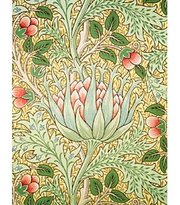Arts and Crafts movement
|
|
The Arts and Crafts movement was a reformist movement, at first inspired by the writings of John Ruskin, that was at its height between approximately 1880–1910. The movement influenced British decorative arts, architecture, cabinet making, crafts, and even the "cottage" garden designs of William Robinson or Gertrude Jekyll. Its best-known practitioners were William Morris, Charles Robert Ashbee, T. J. Cobden Sanderson, Walter Crane, Phoebe Anna Traquair, Charles Rennie Mackintosh, Edwin Lutyens and artists in the Pre-Raphaelite movement. The Arts and Crafts movement was part of the major English aesthetic movement of the last years of the 19th century. In the United States, however, the term is often used to denote the style of interior design that prevailed between the dominant eras of Art Nouveau and Art Deco, or roughly the period from 1910 to 1925.
The Arts and Crafts Movement began primarily as a search for authentic and meaningful styles for the 19th century and as a reaction to the eclectic historicism of the Victorian era and to "soulless" machine-made production aided by the Industrial Revolution. Considering the machine to be the root cause of all evils, the protagonists of this movement turned away from the use of machines and towards handcraft, which tended to concentrate their productions in the hands of sensitive but well-heeled patrons. Though the spontaneous personality of the designer became more central than the historical "style" of a design, certain tendencies stood out: reformist neo-gothic influences, rustic and "cottagey" surfaces, repeating designs, vertical and elongated forms. In order to express the beauty inherent in craft, some products were deliberately left slightly unfinished, resulting in a certain rustic and robust effect. There were also sentimental Socialist undertones to this movement, in that another primary aim was for craftspeople to derive satisfaction from what they did. This satisfaction, the proponents of this movement felt, was totally denied in the industrialised processes inherent in compartmentalised machine production.
In fact, the proponents of the Arts and Crafts movement were against the principle of a division of labour, which in some cases could be independent of the presence or absence of machines. They were in favour of the idea of the master craftsman, creating all the parts of an item of furniture, for instance, and also taking a part in its assembly and finishing, with some possible help by apprentices. This was in contrast to a shop where everything would be oriented towards the fastest production possible, with one person or team doing all the legs of a piece of furniture, another doing all the panels, another assembling the parts and yet another doing the paint and varnish or other finishing work, all according to a plan laid out by a furniture designer who would never actually work on the item during its creation. The movement sought to reunite what had been ripped asunder in the nature of human work, having the designer work with his hands at every step of creation.

Some of the most famous apostles of the movement, like William Morris, were more than willing to design products for machine production, when this did not involve the wretched division of labour and loss of craft talent, which they denounced. Morris designed numerous carpets for machine production in series.
Red House, Bexleyheath, London (1859), by architect Philip Webb for William Morris himself, is a work exemplary of this movement. There is a deliberate attempt at expressing surface textures of ordinary materials, such as stone and tiles, with an asymmetrical and quaint building composition. William Morris formed the Kelmscott Press and also had a shop where he designed and sold products such as wallpaper, textiles, furniture, etc.
Widely exhibited in Europe, the Arts and Crafts movement's qualities of simplicity and honest use of materials negating historicism inspired designers like Henry van de Velde and movements such as Art Nouveau, the Dutch De Stijl group, Viennese Secessionstil and eventually the Bauhaus. The movement can be assessed as a prelude to Modernism, where pure forms, stripped of historical associations, would be once again applied to industrial production.
In the United States, it spawned complementary and sympathetic movements such as the "mission oak" style furniture embraced by Gustav Stickley, the "Prairie School" of Frank Lloyd Wright, the Country Day School movement, and the bungalow style of houses popularised by Greene and Greene. Studio pottery (exemplified by Rookwood pottery, Bernard Leach in England, and Pewabic Pottery in Detroit) as well as the idiosyncratic furniture of Charles Rohlfs also demonstrate the clear influence of Arts and Crafts movement. Mission, Prairie and the California Craftsman styles of homebuilding remain tremendously popular in the United States today.
References
- Cathers, David M. Furniture of the American Arts and Crafts Movement. The New American Library, Inc., 1981. ISBN 045303974.
- Kaplan, Wendy. "The Art that is Life": The Arts & Crafts Movement in America, 1875-1920. New York: Little, Brown and Company, 1987.fr:Arts & Crafts
